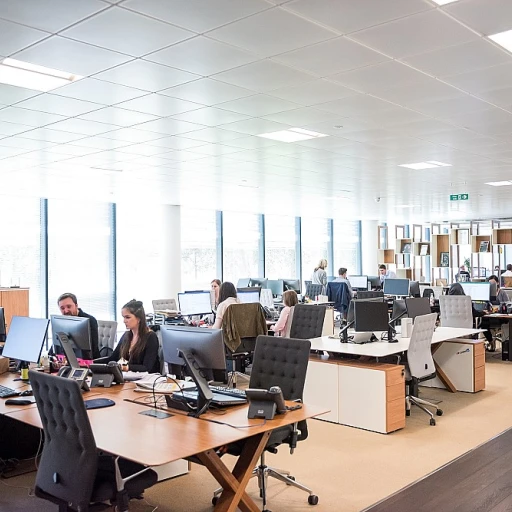
Understanding Environmental Branding
Defining the Key Concepts of Environmental Branding
Employee engagement is increasingly recognized as a critical factor for business success. One concept playing a pivotal role in this engagement is environmental branding, which refers to the strategic use of a company's physical space to express its brand identity. Understanding this term requires a look into several elements that collectively create a cohesive brand experience. Whether it's the graphics on office walls, the design of the furniture, or the wayfinding signage that guides employee movement, every aspect of a corporate office plays a part in expressing the brand's identity. These elements aren't just for aesthetics; they reinforce brand values and create a sense of belonging among employees.Components of Environmental Branding
- Physical Spaces: The design and layout of office spaces can significantly influence employee morale. Well-designed interiors that align with the corporate brand can provoke positive responses, enhancing employee satisfaction and productivity.
- Environmental Graphics: This includes wall graphics and office signage that communicate company values. Expertly designed graphics can subtly yet effectively instill a brand's identity into everyday workspace interactions.
- Wayfinding Signage: Incorporating effective wayfinding systems in an office environment is essential for navigation. These are not merely directional signs but an extension of environmental branding, adding to the overall aesthetic and functionality.
- Branded Corporate Elements: From color schemes to branded office furniture, every element within the office communicates the company’s corporate identity. These elements are designed to resonate with employees at a deeper level, fostering a shared company culture.
The Role of Environmental Branding in Employee Engagement
Connecting Employees with the Brand
Environmental branding plays a pivotal role in enhancing employee engagement by connecting employees with the brand on a deeper level. When employees walk into a corporate office, the physical space should reflect the company's brand identity and values. This connection is not just about aesthetics but about creating a brand experience that resonates with employees daily.
Creating a Sense of Belonging
By incorporating elements like office graphics, environmental graphics, and wayfinding signage, companies can foster a sense of belonging among employees. These elements serve as constant reminders of the company's mission and vision, reinforcing the brand in a subtle yet powerful way. When employees feel aligned with the brand, they are more likely to be engaged and motivated.
Enhancing the Physical Environment
The design of physical spaces, including interior design and wall graphics, can significantly impact employee engagement. A well-designed environment not only enhances the aesthetic appeal but also improves functionality and comfort. This, in turn, can lead to increased productivity and satisfaction among employees.
Supporting Corporate Identity
Environmental branding supports the corporate identity by ensuring that the brand's message is consistently communicated throughout the office environment. This includes everything from the design of branded interior spaces to the use of environmental graphic design. By maintaining a cohesive brand identity, companies can create a unified workplace culture that encourages engagement.
Linking Branding to Engagement Strategies
To effectively leverage environmental branding for employee engagement, companies must integrate it into their broader engagement strategies. This involves considering how branding elements can support initiatives aimed at boosting engagement. For more insights on how businesses can influence policy to boost employee engagement, visit this resource.
Creating a Cohesive Workplace Culture
Fostering a Unified Work Environment
Creating a cohesive workplace culture through environmental branding involves more than just placing logos or employing specific branding designs. It’s about integrating the brand identity into every physical space, enhancing the daily work experience and inspiring employees. By aligning the corporate office environment with the company's values, you can cultivate a sense of belonging and pride among employees.
Interior design plays a critical role in establishing this unified culture. Thoughtful use of environmental graphics and interior design elements—such as office graphics, wall graphics, and wayfinding signage—can subtly, yet powerfully, communicate the company's mission and reinforce brand experience. These design elements serve to narrate the brand’s story within physical spaces, building a stronger emotional connection with employees.
Moreover, the strategic placement of signage and symbolic elements in the workplace can remind employees of their organization's core values. For instance, incorporating designs that reflect sustainability initiatives can generate a positive message and engage employees who value environmental responsibility.
By prioritizing an engaging and reflective physical space, companies can boost employee engagement and encourage employees to be more connected to their work and environment. Integrating environmental branding isn’t just about superficial appearances; it's about creating an environment where employees feel invigorated and motivated every day.
Practical Steps for Implementing Environmental Branding
Integrating Design with Intent
When introducing environmental branding into your workplace, it's crucial to carry a clear vision of what your brand stands for. Start with a comprehensive assessment of your current office space, identifying elements that reflect your company's brand identity. The aim is to create spaces that tell a story about the brand—a narrative that resonates with employees and motivates them.
Strategic Use of Physical Spaces
Consider how different physical spaces can be leveraged to reinforce brand identity. This is where environmental graphics come into play. From wall graphics in meeting rooms to office graphics that inspire creativity in common areas, every element should be purposeful. Incorporating wayfinding signage not only aids in navigation but also subtlety infuses branding throughout the environment.
Design Fabrication and Execution
Partner with designers skilled in environmental graphics and branding design. They can help bring your vision to life, ensuring all graphic elements are aligned with your brand identity. Be sure to consider practical aspects like budgeting and timelines, understanding that design fabrication is an investment in fostering brand experience.
Engaging Employees through Branding Environmental
Empower employees to contribute ideas and feedback on new office designs. This participation fosters a deeper connection to the brand and makes them feel involved in the project. Furthermore, as changes start to take shape, make sure to communicate how these upgrades align with company goals and improve workplace culture. This transparency can significantly boost employee engagement.
Creating Brand Experiences that Last
Finally, continually assess the effectiveness of your environmental branding efforts. Are employees making use of spaces as intended? Is there an increase in collaborative activities? Such insights can help refine ongoing branding efforts and ensure that your workspace remains a dynamic reflection of your corporate identity.
Case Studies of Successful Environmental Branding
Success Stories: Strategic Environmental Branding
In many organizations, environmental branding has been a game-changer in fostering employee engagement. These companies have successfully integrated brand elements into their physical spaces, enhancing both the brand experience and workplace culture.
Transforming the Workplace Atmosphere
One example involves a corporate office that revamped its interior design to reflect its brand identity. By incorporating office graphics and wall graphics that echoed its mission and values, employees felt a stronger connection to the company's goals. The office space was transformed from a generic work environment into a vibrant, inspiring landscape that reinforced the brand's ethos.
Creating a Consistent Brand Identity
Another case study highlights a company's use of environmental graphics and signage to unify its brand identity across multiple locations. This approach not only improved wayfinding signage but also enriched the overall employee experience. The cohesive design elements instilled a sense of pride among staff, boosting morale and engagement levels.
Implementing Practical Design Solutions
A different project focused on personalized design fabrication in a corporate setting. By acknowledging diverse employee needs, the design team crafted spaces that celebrated individuality while aligning with the overarching brand narrative. This personalized approach honored both the company's objectives and the unique contributions of its employees, ultimately strengthening the workplace culture.
These examples underscore the potential of cutting-edge branding techniques to elevate employee engagement. By designating attention to detail in the physical workspace, companies can provide an enriching environment that harmonizes with their brand and resonates with their personnel.
Measuring the Impact of Environmental Branding on Engagement
Assessing the Influence of Environmental Branding
To truly understand the impact of environmental branding on employee engagement, it's essential to adopt both qualitative and quantitative measurement strategies. By assessing different aspects of this approach, companies can refine their designs and strategies for better results.- Employee Feedback and Surveys: Gathering direct feedback from employees through surveys and focused group discussions provides valuable insights into how environmental branding affects their daily experience and morale. Employees can express their feelings about the workplace environment, the effectiveness of wayfinding signage, office graphics, and how these elements contribute to their sense of belonging and identity within the company.
- Observation and Behavioral Metrics: Monitoring changes in employee behavior, such as increased collaborative activities in newly redesigned physical spaces or reduced wayfinding confusion, offers a tangible measure of engagement enhancements. Observational studies can reveal how employees interact with the branded environment and utilize various office spaces designed to foster creativity and collaboration.
- Performance Metrics: Quantitative data such as productivity rates, employee retention statistics, and absenteeism can be pivotal in linking environmental branding to operational outcomes. A well-branded corporate office might lead to higher job satisfaction, which, in turn, promotes better performance and lower turnover rates.
- Space Utilization and Functionality: Analyzing how effectively the physical spaces are used post-implementation can highlight the success of the environmental graphics and interior design elements. Evaluating whether employees gravitate towards certain branded zones or whether all functional areas are equally utilized sheds light on the practical efficacy of the branding project.
- Comparative Studies: By comparing different offices within the same company or similar companies with and without robust environmental branding, stakeholders can better gauge the impact. Such comparative analyses can elucidate the distinctive benefits derived from coherent brand identity and design environmental strategies that transcend basic aesthetics.













